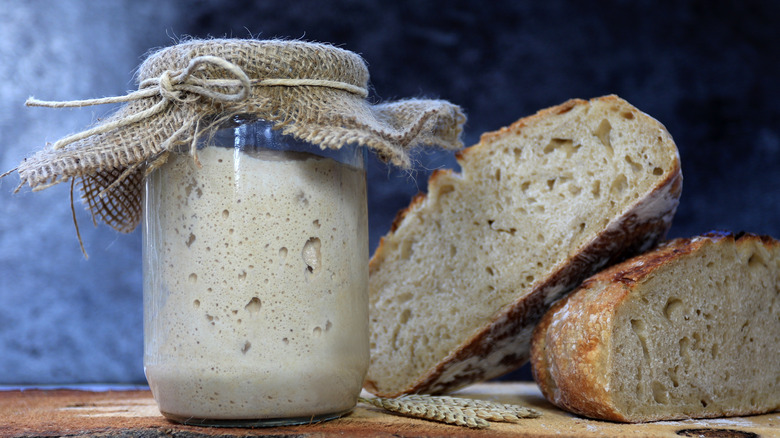Sourdough Bread Has An Unexpected Amount Of Protein
Staying home during the early stages of the COVID-19 pandemic inspired many amateur bakers to spend more time in the kitchen. A popular trend was sourdough bread, which isn't made from store-bought yeast but a homemade starter. The starter uses just flour and a little water, but it requires several days to ferment.
It's the fermentation of sourdough bread that makes it different from other types of bread. Compared to white and wheat bread, sourdough bread has slightly more protein — 3.7 grams per slice. Protein is made of amino acids, and sourdough provides all nine of the essential amino acids that your body needs. Sourdough is a good source of tryptophan, which your body needs to produce serotonin and melatonin. You'll also find a healthy amount of the conditional amino acid cysteine to help with your skin's elasticity (per University of Rochester Medical Center). Aside from the protein in sourdough bread, the fermentation process makes many of its nutrients more available to your body.
Sourdough is easier on your digestive system
Although the sourdough starter contains live bacteria and yeasts, the baking process kills these microorganisms, so sourdough bread isn't considered to be a probiotic. Sourdough's fermentation process weakens the bonds in gluten proteins, making it easier to digest for some individuals with mild gluten sensitivities, though it may still not be suitable for those with celiac disease or severe allergies. Some people have problems digesting fermentable short-chain carbohydrates (FODMAPs), which can cause gas and other gastrointestinal symptoms. The fermentation in sourdough bread can reduce FODMAPs by as much as 95% depending on the type of flour and length of the fermentation process, according to a 2023 review in Frontiers in Nutrition.
Sourdough's fermentation process increases the ability of your body to absorb some of its vitamins and minerals more easily, according to a 2021 review in Current Opinion in Food Science. Even though the microbes that come alive during the fermentation process don't survive in the oven, the byproducts of the fermentation process include peptides, amino acid derivatives, and prebiotics that can improve your health.
What to look for in sourdough bread
Like any other type of bread, sourdough bread can differ in nutrients depending on the type of flour, length of fermentation, and amount of processing. The sourdough bread you find in the grocery aisle might have more ingredients to increase its shelf life compared to the sourdough bread made fresh in your favorite bakery. A true sourdough bread will list flour, water, and salt, with a few other ingredients such as nuts, seeds, or raisins.
On the other hand, some sourdough bread might be labeled as such even though it might use commercial baker's yeast, according to Colorado State University. Labels like "Seattle," "Extra Sourdough," or "Sprouted Sourdough" are more for marketing purposes. The ingredient label for sourdough-flavored breads will be telling if it's not naturally leavened. Baker's yeast and baking soda leaven the bread, and acetic acid, yogurt, and vinegar might be added to make the bread taste like natural sourdough. Benzoic acid and cultured wheat are used to preserve the bread and extend its time on the grocery store shelves. These commercial sourdough breads might not have the same health benefits associated with traditional sourdough bread.



